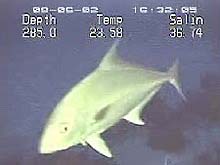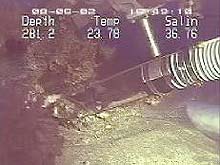
Upon the JSL II’s exploration of The Steeples, the submersible crew encounters groupings of Almaco jacks swimming near higher relief areas.
Up Close and Personal on a North Carolina Deep Reef
August 08, 2002
Ken Sulak, Geological SurveyFlorida Caribbean Science Center, U.S.
![]() Watch a video of the Johnson Sea-Link during a dive, while the chief scientist, Steve Ross, describes the dive's goals. (mp4, 1.7 MB).
Watch a video of the Johnson Sea-Link during a dive, while the chief scientist, Steve Ross, describes the dive's goals. (mp4, 1.7 MB).
![]() During a dive at a site known as The Steeples, the submersible crew encounters groupings of Almaco jacks. (mp4, 1.1 MB).
During a dive at a site known as The Steeples, the submersible crew encounters groupings of Almaco jacks. (mp4, 1.1 MB).
![]() Watch a video of fish swimming around spatially complex areas such as boulders and caves. (mp4, 1.4 MB).
Watch a video of fish swimming around spatially complex areas such as boulders and caves. (mp4, 1.4 MB).
Although the scientific method suggests that science proceeds primarily by hypothesis and experimental testing, much of what we know about the natural world actually comes from empirical observation. The NASA Viking and Mariner expeditions amply demonstrated the fundamental importance of direct close-up observation. As eloquently portrayed in Carl Sagan's "Pale Blue Dot," our knowledge of the solar system's planets and moons was totally revolutionized by images from these two exploratory missions. In the deep underwater world, direct observation, imaging and sampling from submersibles are similarly revolutionizing our knowledge of the world's oceans.
We know the fish fauna of deep reefs on the Carolina shelf primarily from the groupers, snappers and other food fishes landed by commercial fishermen. Our second dive of this expedition leg in the Johnson-Sea-Link II (JSLII) submersible provided a closer look at this fauna. Descending 400 feet to the ocean floor, we landed on a field of large, irregular boulders, pieces of the continental shelf broken off by erosion and geological events and scattered by storm currents. Most were 2 to 4 feet in diameter, but some were much larger. Lying on the otherwise featureless sand plain of the outer shelf, these boulders support oases of life. Soft corals, black corals and other plankton-feeding invertebrates anchor themselves to the hard rock substrate, in turn providing a living habitat for fishes, crabs, shrimps and other mobile inhabitants. As a fish biologist, my focus was on the fishes of this area, known as the "Steeples." Although we are exploring deep water, far north of the tropics, the influence of the warm Gulf Stream dictates that the dominant fishes are Caribbean reef fishes. Bottom temperatures throughout the dive were 25 to 29oC.

Many types of fish species are found in and around spatially complex areas such as boulders and caves. To collect these fish, the JSLII squirts rotenone (a type of anesthetic) into the cave.
A primary objective of this dive was to compare the fish species recorded from the submersible with those caught earlier in the day by a commercial fishing boat. Indeed, we saw many of the same top predators, including yellowmouth grouper, red snapper, vermilion snapper, scamp and porgy, that typically wind up in the local fish market. But through the eye of the submersible, we saw much more. The fauna is incredibly diverse, probably including at least 50 species. Most abundant are the small species that pick plankton from the water column, or that feed on tiny animals hiding in rock crevices and among the miniature forest of attached invertebrates. Few of these are familiar to fishermen. They include the tiny red and yellow streamer basses that swarm over and around the boulders, and small candy-striped wrasses that use their pectoral fins to row along the bottom with a peculiar sliding motion, exploring for small invertebrate prey.
During the first Islands in the Stream expedition in 2001, just a few dives revealed several fish species not previously known north of the coast of Florida, proving how little is really known about the deep reef fauna. In 2002, this dive added another up-close and personal look at this fauna, and new information on the overall community that supports an important food fishery.
Sign up for the Ocean Explorer E-mail Update List.














































